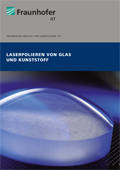Polishing glass and plastic materials with CO2 laser radiation is based on the absorption of the radiation in a thin border layer of the work piece such that temperatures just below the evaporation temperature are attained on the surface. As a result, the viscosity of the material is reduced so that the roughness flows and the surface is smoothened due to surface tension. In comparison to conventional polishing methods, the innovation of laser polishing lies in a fundamentally different active principle: surface smoothing through remelting rather than material removal. This way, laser polishing achieves, among other things, a favorable smaller micro roughness.
By choosing the corresponding process parameters, such as preheating temperature, feed speed and intensity distribution, a user can flexibly adapt laser polishing to nearly any surface form. Due to the high process speeds of up to 1 cm2/s for quartz glass and up to several 10 cm2/s for plastics, laser polishing is faster than conventional polishing processes by up to two magnitudes.

 Fraunhofer Institute for Laser Technology ILT
Fraunhofer Institute for Laser Technology ILT